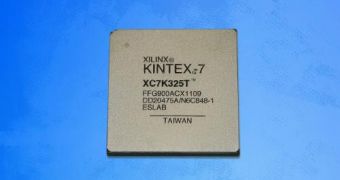Pico Computing, a company specialized in designing high-performance FPGA platforms, has recently announced the development of the M-505 module, the first board to be released with the new Xilinx Kintex-7 FPGA, the world’s first shipping 28nm programmable logic device.
The M-505 has been designed to be used in conjunction with Pico’s current EX-500 PCIe backplane in order to give users an easy upgrade path to the Xilinx' new field programmable gate arrays.
Kintex-7 FPGAs are the mid-range of Xilinx' new 7-series families of such devices and are built using TSMC’s high-performance, low-power (HPL) 28nm fabrication node.
According to Pico Computing, this technology delivers a twofold price/performance improvement while consuming 50% less power than previous generation FPGAs.
The M-505 features a Xilinx Kintex-7 XC7K325T with one DDR3 SODIMM providing up to 12.8 GB/s of local memory bandwidth to the FPGA, while communication with the host takes place through an x8 PCI-Express interface.
There are 34 LVDS and eight GTX transceivers on the M-505, and it can be configured independent of a host system, as a stand-alone module for embedded applications.
Up to six such modules can fit on an EX-500 PCIe backplane, allowing for a maximum of 48 FPGAs in Pico’s SC5 SuperCluster.
"Pico Computing is demonstrating technical leadership with the M-505 by pairing the Kintex-7 with their scalable FPGA board architecture,” said Prasanna Sundararajan, Sr. Staff Systems Architect, HPC, at Xilinx.
“This is a low-power high-density high performance solution that outperforms many other HPC solutions including multi-core systems for integer applications that involve search and pattern matching operations.”
Pico Computing will demonstrate its M-505 module at the 2011 Supercomputing Conference which will take place between November 12 - 18, 2011 in Seattle, Washington.
Production boards will be available in the second quarter of 2012, while the beta program opens in the first quarter of 2012.

 14 DAY TRIAL //
14 DAY TRIAL //